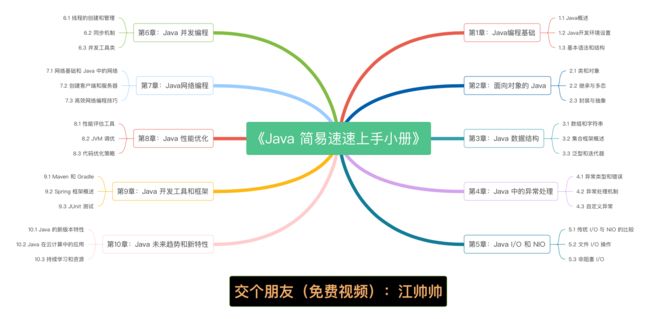《Java 简易速速上手小册》第3章:Java 数据结构(2024 最新版)
文章目录
- 3.1 数组和字符串 - 数据的基本营地
-
- 3.1.1 基础知识
- 3.1.2 重点案例:统计文本中的单词频率
- 3.1.3 拓展案例 1:寻找数组中的最大元素
- 3.1.4 拓展案例 2:反转字符串
- 3.2 集合框架概述 - 数据小队的训练场
-
- 3.2.1 基础知识
- 3.2.2 重点案例:学生信息管理系统
- 3.2.3 拓展案例 1:任务调度器
- 3.2.4 拓展案例 2:产品库存管理
- 3.3 泛型和迭代器 - 数据小队的特种兵
-
- 3.3.1 基础知识
- 3.3.2 重点案例:通用数据容器
- 3.3.3 拓展案例 1:键值对存储
- 3.3.4 拓展案例 2:类型安全的交换函数
3.1 数组和字符串 - 数据的基本营地
在 Java 的世界中,数组和字符串是处理数据的基础。它们像是你的数据小队的营地,为你的编程之旅提供了起点。让我们更深入地了解这些基础结构,并通过一些实用的案例来探索它们的力量。
3.1.1 基础知识
- 数组:数组是相同类型数据的有序集合。在 Java 中,数组的大小在声明时确定,并且不能更改。你可以通过索引(从 0 开始)访问数组中的每个元素。
int[] numbers = new int[5]; // 声明一个整型数组,包含 5 个元素
numbers[0] = 1; // 给数组的第一个元素赋值
- 字符串:字符串是字符的序列,Java 中的
String类提供了丰富的方法来操作这些字符序列。字符串在 Java 中是不可变的,这意味着一旦创建,你就不能改变它们。
String greeting = "Hello, World!"; // 创建一个字符串
3.1.2 重点案例:统计文本中的单词频率
假设我们要分析一段文本,统计其中每个单词出现的频率。这个任务可以通过数组和字符串操作来完成。
import java.util.HashMap;
import java.util.Map;
public class WordFrequency {
public static void main(String[] args) {
String text = "Hello world. Hello Java. Hello Java World.";
text = text.toLowerCase().replaceAll("[^a-z ]", ""); // 转小写并移除标点符号
String[] words = text.split(" "); // 使用空格分割字符串成单词数组
Map<String, Integer> frequencyMap = new HashMap<>();
for (String word : words) {
frequencyMap.put(word, frequencyMap.getOrDefault(word, 0) + 1);
}
frequencyMap.forEach((key, value) -> System.out.println(key + ": " + value));
}
}
3.1.3 拓展案例 1:寻找数组中的最大元素
在一组数据中寻找最大元素是一个常见的任务,可以通过遍历数组来实现。
public class FindMax {
public static void main(String[] args) {
int[] numbers = {5, 3, 8, 2, 9, 1};
int max = numbers[0]; // 假设第一个元素是最大的
for (int number : numbers) {
if (number > max) {
max = number; // 找到更大的元素
}
}
System.out.println("The maximum number is: " + max);
}
}
3.1.4 拓展案例 2:反转字符串
字符串的反转是许多算法和面试题中的常见问题。在 Java 中,我们可以使用 StringBuilder 类来实现这个功能,因为 String 是不可变的。
public class ReverseString {
public static void main(String[] args) {
String original = "Hello, World!";
String reversed = new StringBuilder(original).reverse().toString();
System.out.println("Original: " + original);
System.out.println("Reversed: " + reversed);
}
}
通过这些案例,我们可以看到数组和字符串如何作为处理数据的基本工具,在 Java 编程中发挥着重要的作用。从统计单词频率到寻找最大元素,再到反转字符串,掌握这些基础技能将为你解决更复杂的问题打下坚实的基础。继续前进,实践这些案例,你将会发现更多有趣和实用的数据处理技巧!
3.2 集合框架概述 - 数据小队的训练场
Java 集合框架(JCF)是一套性能优异的类和接口,它提供了一种高效地存储和处理数据集合的方式。想象你正在指挥你的数据小队在训练场上进行训练,集合框架就是你的训练手册,告诉你如何组织和操作这些数据。
3.2.1 基础知识
-
List:List 接口允许我们存储一个有序的集合,可以包含重复的元素。它是一个动态数组,可以增长和缩小。ArrayList 和 LinkedList 是两个实现了 List 接口的常用类。
-
Set:Set 接口提供了存储唯一元素的方式,即不允许重复的元素。HashSet 和 TreeSet 是两个常用的实现了 Set 接口的类。
-
Map:Map 接口使用键值对的方式存储数据。每个键映射到一个值。键不能重复,但值可以。HashMap 和 TreeMap 是两个实现了 Map 接口的常用类。
3.2.2 重点案例:学生信息管理系统
在一个学生信息管理系统中,我们需要存储和管理每个学生的信息,包括姓名、学号和成绩。我们可以使用 Map 来实现这个系统,其中学号作为唯一的键,学生信息作为值。
import java.util.HashMap;
import java.util.Map;
class Student {
String name;
double grade;
public Student(String name, double grade) {
this.name = name;
this.grade = grade;
}
@Override
public String toString() {
return "Student{name='" + name + '\'' + ", grade=" + grade + '}';
}
}
public class StudentManagement {
public static void main(String[] args) {
Map<String, Student> students = new HashMap<>();
students.put("S001", new Student("Alice", 89.5));
students.put("S002", new Student("Bob", 92.0));
students.put("S003", new Student("Charlie", 85.5));
students.forEach((id, student) -> System.out.println(id + ": " + student));
}
}
3.2.3 拓展案例 1:任务调度器
在一个任务调度器中,我们需要管理和调度一系列的任务。我们可以使用 PriorityQueue 来实现这个系统,优先调度重要性高的任务。
import java.util.PriorityQueue;
class Task implements Comparable<Task> {
String name;
int priority;
public Task(String name, int priority) {
this.name = name;
this.priority = priority;
}
@Override
public int compareTo(Task other) {
return Integer.compare(other.priority, this.priority); // 高优先级先出队
}
@Override
public String toString() {
return "Task{name='" + name + '\'' + ", priority=" + priority + '}';
}
}
public class TaskScheduler {
public static void main(String[] args) {
PriorityQueue<Task> tasks = new PriorityQueue<>();
tasks.offer(new Task("Fix bug", 5));
tasks.offer(new Task("Write documentation", 1));
tasks.offer(new Task("Implement feature", 10));
while (!tasks.isEmpty()) {
System.out.println("Processing " + tasks.poll());
}
}
}
3.2.4 拓展案例 2:产品库存管理
在一个电商平台的库存管理系统中,我们需要跟踪每个产品的库存数量。我们可以使用 Map 来存储产品 ID 和对应的库存数量。
import java.util.HashMap;
import java.util.Map;
public class InventoryManagement {
public static void main(String[] args) {
Map<String, Integer> inventory = new HashMap<>();
inventory.put("P001", 100); // 产品 ID 为 P001 的产品有 100 件库存
inventory.put("P002", 200);
inventory.put("P003", 150);
// 增加库存
inventory.put("P001", inventory.get("P001") + 50);
inventory.forEach((productId, quantity) ->
System.out.println("Product ID: " + productId + ", Quantity: " + quantity));
}
}
通过这些案例,我们可以看到 Java 集合框架在实际生产中的强大用途。从管理学生信息到任务调度,再到库存管理,JCF 提供了一套灵活且强大的工具,帮助你高效地组织和操作数据集合。掌握这些集合类和接口将大大提高你的 Java 编程效率。
3.3 泛型和迭代器 - 数据小队的特种兵
在 Java 的数据管理军团中,泛型和迭代器是那些特别训练过的特种兵,它们提供了额外的灵活性和力量,使得数据操作更加高效和安全。
3.3.1 基础知识
- 泛型(Generics):泛型提供了代码的类型安全性,允许在编译时检查类型错误。它们使得你可以编写可以应用于多种类型的通用代码,而不是为每种需要操作的数据类型编写重复的代码。
List<String> strings = new ArrayList<>(); // 使用泛型创建字符串列表
strings.add("Java");
// strings.add(123); // 编译时错误,保证了类型安全
- 迭代器(Iterator):迭代器提供了一种遍历集合中元素的标准方式,无需关心集合的内部结构。它支持
hasNext()和next()操作,用于检查集合中是否还有元素,以及访问下一个元素。
Iterator<String> iterator = strings.iterator();
while(iterator.hasNext()) {
String str = iterator.next();
System.out.println(str);
}
3.3.2 重点案例:通用数据容器
假设我们需要创建一个通用的数据容器,它可以存储任何类型的数据,并提供遍历这些数据的能力。我们可以使用泛型来定义这个容器,以及迭代器来遍历容器中的数据。
class DataContainer<T> implements Iterable<T> {
private List<T> data = new ArrayList<>();
public void add(T element) {
data.add(element);
}
@Override
public Iterator<T> iterator() {
return data.iterator();
}
}
public class GenericDemo {
public static void main(String[] args) {
DataContainer<String> stringContainer = new DataContainer<>();
stringContainer.add("Hello");
stringContainer.add("World");
for (String str : stringContainer) {
System.out.println(str);
}
}
}
3.3.3 拓展案例 1:键值对存储
在许多应用中,我们需要存储键值对数据。我们可以创建一个通用的键值对类,并使用泛型来定义键和值的类型。
class KeyValuePair<K, V> {
private K key;
private V value;
public KeyValuePair(K key, V value) {
this.key = key;
this.value = value;
}
public K getKey() {
return key;
}
public V getValue() {
return value;
}
}
public class KeyValuePairDemo {
public static void main(String[] args) {
KeyValuePair<String, Integer> ageOfPerson = new KeyValuePair<>("Alice", 30);
System.out.println(ageOfPerson.getKey() + ": " + ageOfPerson.getValue());
}
}
3.3.4 拓展案例 2:类型安全的交换函数
在进行数据处理时,我们经常需要交换两个元素的位置。我们可以编写一个使用泛型的交换函数,以确保我们可以安全地交换同一类型的两个元素。
public class SwapDemo {
public static <T> void swap(T[] array, int pos1, int pos2) {
T temp = array[pos1];
array[pos1] = array[pos2];
array[pos2] = temp;
}
public static void main(String[] args) {
Integer[] numbers = {1, 2, 3, 4, 5};
swap(numbers, 1, 3); // 交换位置 1 和位置 3 的元素
System.out.println(Arrays.toString(numbers));
}
}
通过这些案例,我们可以看到泛型和迭代器如何增强 Java 程序的灵活性和类型安全性。泛型让我们可以编写可重用且类型安全的代码,而迭代器则提供了一种标准的方法来遍历集合中的数据。掌握这些特种兵的技能将使你在处理复杂数据时更加得心应手。继续前进,勇敢地使用这些工具来解决你面临的编程挑战吧!


